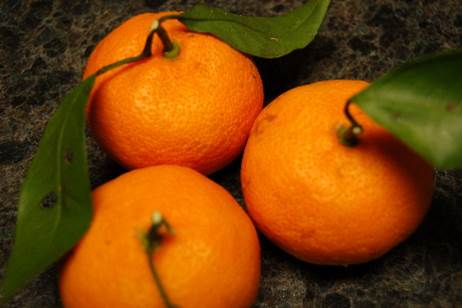
by Matthew Orwat | Nov 24, 2015

Satsuma fruit, harvested with their stem intact to ensure longevity when stored. Image Credit: Dr. Pete Andersen
The satsuma mandarin (Citrus unshiu) is a popular dooryard fruit tree, and emerging crop, across the Florida Panhandle. 100-150 years ago it was a major cash crop for the region, with boxcar loads being shipped to the Northeast during the months of October-December. Due to a series of hard freezes in the 1950s and a shift in land use from produce production to timber, the satsuma industry was effectively dead in northwest Florida until recent years, when several entrepreneurial growers have invested time and effort in bringing back this delicious citrus to the commercial scene.
Throughout this time, many homeowners have enjoyed this historic citrus, dressing many a Thanksgiving table with its beautiful bright orange fruit. Satsumas contain few seeds, are generally sweet and very easy to peel. They are part of the mandarin group of citrus, and somewhat resemble canned mandarin oranges in shape and flavor. The cooler the fall temperatures (above freezing) the sweeter the fruit will be at harvest.
Mature trees are hardy down to 14-18 º F when budded to a cold hardy rootstock such as trifoliate orange or swingle. Young trees need to be protected from temperatures below the mid 20s, and fruit will be ruined if exposed to any freezing temperatures below “light frost” conditions. Commercial growers use protective techniques, such as microirrigation, to protect their fruit if freezing temperatures threaten harvest.
This Thanksgiving, if you do not have a satsuma tree of your own, seek out a local producer and buy a case of satsumas for the holiday season !
For more information on growing and harvesting satsuma mandarins consult “The Satsuma Mandarin – HS195“, produced for your benefit by UF / IFAS Extension.
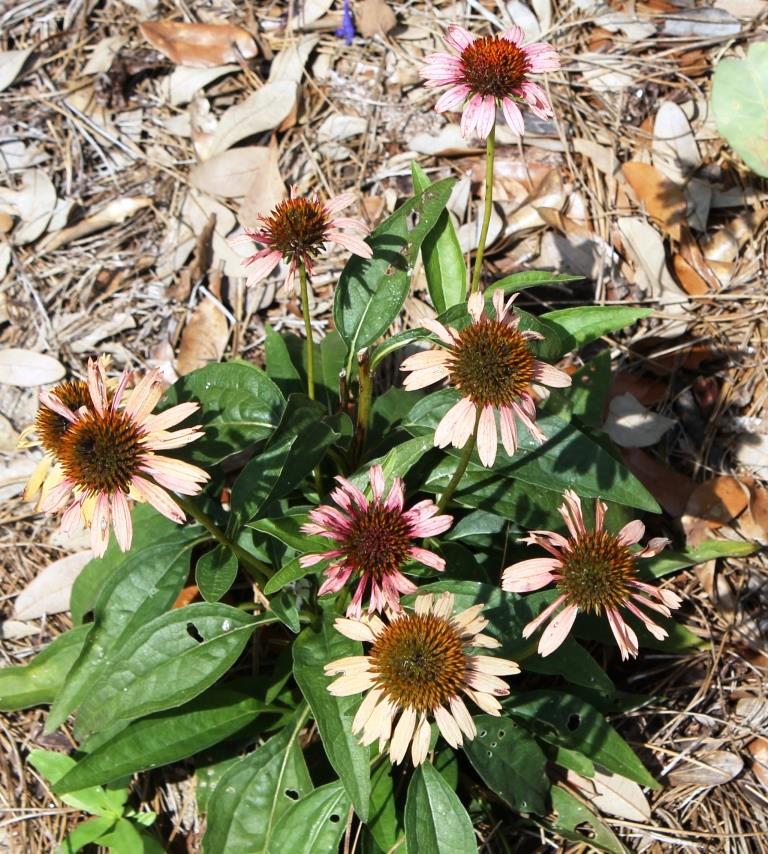
by Matthew Orwat | Nov 20, 2015
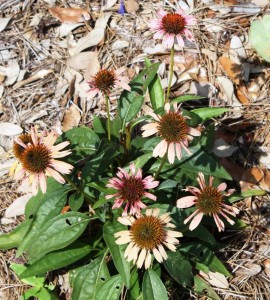 Although it seems like summer outside, especially with such warm weather the week before Thanksgiving, winter temperatures will be coming. Possibly sooner rather than later. Perennials that are meant to die to the ground each winter look ugly and decayed after the first frost. Faced with such unattractive plants, most gardeners are inclined to cut them to the ground right away. That action might be a mistake.
Although it seems like summer outside, especially with such warm weather the week before Thanksgiving, winter temperatures will be coming. Possibly sooner rather than later. Perennials that are meant to die to the ground each winter look ugly and decayed after the first frost. Faced with such unattractive plants, most gardeners are inclined to cut them to the ground right away. That action might be a mistake.
Many perennials, such as hibiscus species, hydrangea, salvia species, firebush (Hamelia patens), rudbeckia, echinacea, lantana and others still have a large amount of starch stored in their branches, even after the first frost. Although it is very tempting to remove these unattractive reminders of the beautiful spring gardening season, it is better to wait to allow the starch to translocate (move) down to the root system. The time that this takes varies by plant species, but can be as late as February.
To determine if there is “life” left in those burned and singed stems, just scratch off the top layer of the stem. If any nutrients remain in the stem, it will be green or yellow where the scratch was made. If it is brown and dead, it is safe to prune the perennial back.
If you can stand to wait, allow those unsightly stalks to remain until February. If they contain any plant nutrients this will give the plant some energy during the winter months. This is not possible in every situation, but following this practice will bring stronger flowering perennials next season!
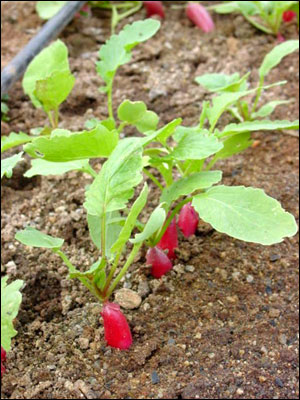
by Matthew Orwat | Nov 13, 2015

Radishes ready to harvest. Image Credit, UF / IFAS Gardening Solutions
Floridians are lucky, in that they are able to grow many vegetables throughout the winter months. If a fast growing, quick producing vegetable is desired, nothing is faster than a radish. Radishes can develop from seed to mature root in 20-30 days, and can be planted any time between September and March. The cooler months of October to February are even better since radishes do not develop the “hot” flavor when grown in cooler temperatures. There is less risk of that occurring during the cooler months of fall and winter.
Radishes should be direct seeded in the garden at a depth of 0.25 inches. They should be seeded 1 inch apart, with rows 6 inches apart. It is important that they not be crowded since the edible root portion will not form properly unless the plants are given plenty of space. Once plants emerge, thin them to about 3 inches apart.
At planting, plenty or organic matter and fertilizer should be incorporated in the bed. If soil is not well-drained garden in a raised bed. Avoid fertilizing once the seeds have germinated. Make sure to provide uniform irrigation and a weed free environment.
Harvest should take place when the radishes are ready (20-30 days), but fairly young to ensure a mild tasting root.
For more information consult Root Crop Production in Florida, part of the Florida Vegetable Production Handbook
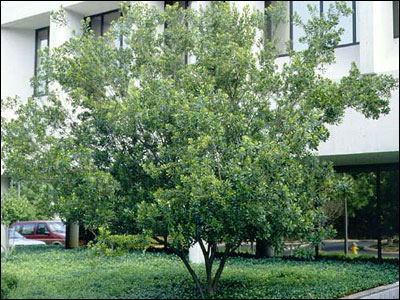
by Matthew Orwat | Nov 5, 2015

Waxmyrtle. Image Credit UF / IFAS Solutions
Myrica cerifera Southern Waxmyrtle, Bayberry is a large shrub to small tree that is now native to much of Florida and much of the Southeastern United States. It was introduced to Europeans in the 1700s and is considered native by many botanical authorities. Sources disagree to the validity of its native status. It is usually found as an understory plant in lightly forested areas, swamps, brackish areas, as well as around old home sites.
It was planted widely in the 18th,19th and early 20th century as a plant for medicinal and industrial purposes. Four pounds of its berries will yield one pound of wax for candle making. When processed, this wax was also used in surgeon’s soap, shaving lather, and sealing wax. Fermented leaves were used to produce a substance which was said to treat fever, stomach aches, and headaches.
Southern Waxmyrtle can reach up to 25 feet but is best maintained as a 10-20 foot multi-trunked shrub or small tree. It can also be trained as a smaller hedge and several dwarf form exist. Landscapes are enhanced by the shrubs’ olive green foliage, leaf aroma, open, rounded form and waxy blue-green berries. Wildlife enjoy the berries as a food source as well. They can provide dappled shade for outdoor entertainment spaces or front entrances.
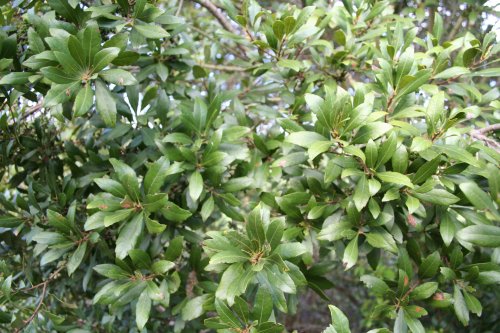
Waxmyrtle Leaves. Image Credit Brent Sellers – UF / IFAS Extension
Another benefit of Waxmyrtle is that it can be used in tough-to-landscape roadside and coastal areas since it is both pollution and salt tolerant and will cease to require irrigation once it is established. ‘Pumila’ is a dwarf cultivar suitable to small spaces.
Waxmyrtle is susceptible to few pests and diseases but can occasionally be attacked by webworms, mites and caterpillars. These can be controlled by pruning out of infested areas, forceful applications of water or Bt (Bacillus thuringiensis for caterpillar). It is also occasionally susceptible to canker on old branches and Fusarium wilt in central and south Florida. It is also considered a weed in pasture situations.
References:
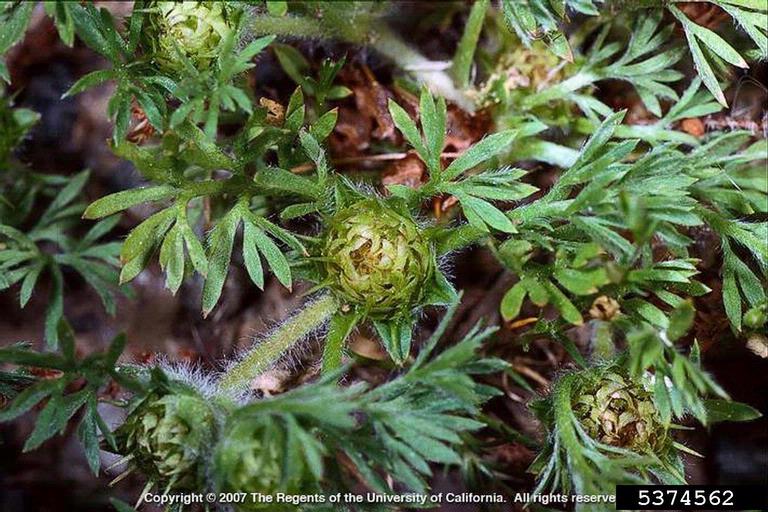
by Matthew Orwat | Oct 6, 2015
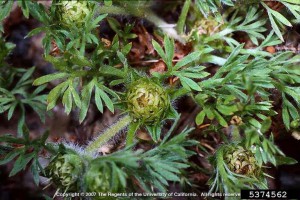
Lawn Burweed, Soliva Sessilis, Closeup – Image Credit: Joseph M. DiTomaso, University of California – Davis, Bugwood.org, Create Commons License
On this bright and sunny early fall morning I was thinking about all of the great gardening opportunities the cooler fall weather is bringing us in the Florida Panhandle. However, my thoughts drifted to the annoyances that the gardeners find when trying to enjoy their lawn or garden.
On the top of my list is stepping into a patch of burweed, which is in the sunflower family and is also known as spurweed. The leaves are opposite along the stem and sometimes resemble parsley. The main ways which burweed can irk the casual gardener are sticking to socks, sneaking in with the dog, or littering flower beds with its nuisance. It can also hide in the house and reappear when shoes are removed. This causes pain in both the foot and the ear.
Aside from herbicides, maintaining a healthy vigorous lawn will prevent weeds from taking over. If you lawn is reasonably healthy and only a few instances of this weed exist, try to mechanically remove them and encourage the lawn to outgrow them.
If cultural methods aren’t sufficient, science has given us several options to control this irksome pest. A widely used pre-emergence product for burweed control is isoxaben, which is sold under the brand name of Gallery as well as others. It prevents the weed from emerging from the ground when it germinates and can be used on St. augustine, centipede, bahia and zoysia lawns, as well as ornamental shrub beds. In northwest Florida, this herbicide needs to be applied in October for best results.
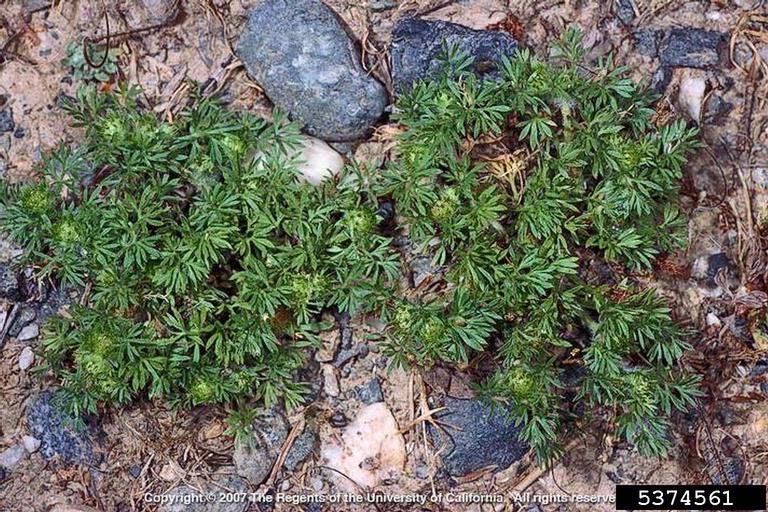
Burweed, Soliva Sessilis. – Image Credit: Joseph M. DiTomaso, University of California – Davis, Bugwood.org. Creative Commons License
Herbicides which contain the active ingredients dicamba, 2,4-D or atrazine are good at controlling burweed as a post emergence control when applied from December through early March. Be careful to use reduced rates on centipede and St. augustine lawns, and never use more than the labeled rate. Later applications have less effect on burweed because as it matures it is harder to control. Additionally the burs, once present on the lawn, are hard to remove. As the daytime temperatures get a few degrees over 80, some of these herbicides may cause lawn damage so immediate application is advised. Try to keep the spray residue outside of the root zone of desirable plants to avoid injury and always follow label directions. Be aware that burweed reproduces by seed, so mowing it down will only increase the problem by burying the seed for fall germination.
The active ingredients mentioned above are present in a variety of ‘trade name’ products* available from your local garden center, farm supply or CO-OP. I hope all the northwest Florida lawns prevent burweed so that the spring lawns will be burweed free. Happy Gardening!
| Common Name |
Manufacturer / Distributor |
Brand Names |
Type |
| Atrazine |
Many |
Many |
Pre and Post Emergent |
| 2,4-D +
MCPP + dicamba (3 way combined herbicide) |
Bayer, + others |
Many |
Post-Emergent |
| Isoxaben |
Dow, Others |
Gallery, others are now on the market |
Pre-Emergent |
*Table reproduced from sections of the 2012 version of University of Florida’s Pest Control Guide for Turf Grass Managers.










